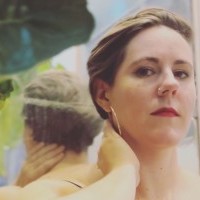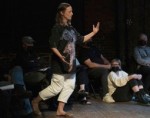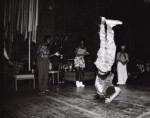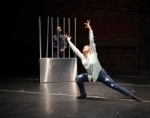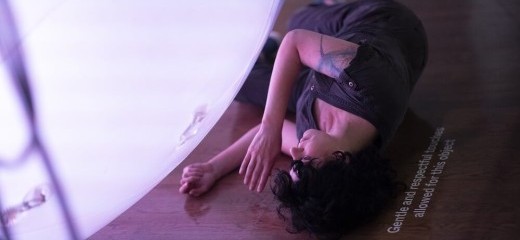
Locating the Sea Inside
by Ella-Gabriel Mason
This month dance-maker Nicole Bindler* shares a solo version of an ensemble work, last presented in 2018, curated by Morgan Fitzpatrick Andrews at Studio 34. I corresponded with Bindler to learn more about her process of adaptation and how she works with somatic practices as a compositional source.
Ella-Gabriel Mason: In the performance description you mention that the title of this work is shared with a short story by Italo Calvino in which he uplifts the parallel levels of salinity in ocean water and human blood. Does this work draw further inspiration from Calvino?
Nicole Bindler: Calvino’s short story, Blood, Sea, in his collection t zero, describes a car ride among people who have existed together for millions of years, evolving from oceanic beings to terrestrial creatures. The story dovetails their quotidian, present-day drive in a Volkswagen and their glacial bodily evolutions. We all arose from single-tissued sea sponges that could filter and absorb nutrients through their pores—to multi-tissued apes with vessels carrying the sea inside of us. “Before, we swam, and now we are swum.” The story describes the phenomenon of form following function: As we grew and complexified over many generations, our bodies became too large to distribute nutrients through the simple porous filtration system, necessitating the development of vessels to transport the ocean through us. My interest in invagination was sparked by this story 25 years ago from which I learned that our blood vessels developed through fractal formations of cavities folding and outpouching; complicating the question of what is inside and what is outside.
[. . .]
I have always problematized the idea of inside/outside in my performance work by playing with the borders of the performance space and the boundary between audience/performer. We invite the audience to move to different vantage points throughout the evening, and my dancing and Julius Masri’s soundscape move through all the edges of the space, including behind the audience, around corners, and potentially even outside of the room. I enjoy subtly provoking audiences to consider their important role in the performance by turning their attention to their own bodies and breath as a part of the choreography.
EGM: Part of your research involved exploring the organ systems impacted by the flow of blood. Were there particular systems that proved more fruitful or easier to access? Were there any that proved more elusive?
NB: I am particularly interested in initiating movement from the liver and spleen because of the challenge of accessing them, and the unusual movement options they generate. Both of these organs filter blood. They are heavy and dense, and live just below the respiratory diaphragm. In our embryonic development the spleen begins in the back and the liver is in the front. Around week four they rotate around each other horizontally. The liver ends up on the right and the spleen on the left. They drag their connective tissue compartments along for the ride, and they recapitulate this pathway with every breath we take. The diaphragm moves downward on the inhale and upward on the exhale, displacing the organs that dance and sway through the trajectory in which they originally traveled. Sensing and moving from these two particular organs gives me a feel for my weight, volume, density, and three-dimensionality. In many forms of dance training there is a tendency to constrict and hold in the lower ribs to maintain core stability. What is lost in these forms is the capacity to mobilize and express from the middle of the torso. Moving from these organs that are nestled up in the diaphragm and lower ribs enables a kind of folding in my torso that I can’t find otherwise. Tuning into the liver and spleen allows me to access a more spiralic sensibility and an expressiveness that travels all the way out through my limbs.
EGM: What techniques do you draw on to gain access to these systems and to then draw compositional material out of those experiences?
NB: I use the tools I learned in my eight years of study at the School for Body-Mind Centering® (BMC®) to cultivate presence and skill in my movement practice. I also use BMC methods to develop choreographic ideas through embryonic images and memories. This can involve looking at images and videos of embryological processes, writing and teaching about embryology, meditating about how all my body systems emerged, tracing the pathways of developing tissues inside my body, or creating a large map of those pathways with my whole body in the space.
EGM: In doing somatic work myself, I have sometimes had very intense proprioceptive and emotional experiences of contact with different body systems, coordinations, and memories which are not visually accessible from an outside perspective. Which is to say, sometimes dramatic somatic experiences don’t look like much to an outside viewer! Has this come up for you in the process of making somatically driven work?
NB: My personal practice is very internal, but my performance practice relies on a connection with the audience. I cultivate this connection through the way I see them, inspired by my years of study with Deborah Hay who trains dancers in performance presence. I also communicate with the audience by enlarging and externalizing the embryological ideas using my whole body and the space. For example, rather than just feeling my heart beat, I might move from my heart by articulating the space at the center of my thoracic cavity, or even walk a pathway in the space that maps the spiral trajectory the heart takes as it forms embryologically.
EGM: A review of a previous group version of Blood, Sea draws a lot of meaning from the imagery created by multiple bodies moving in moments of both clear and ambiguous coordination. What was important to you about the “groupness” of the previous work and how does that change in exploring this work as a solo improvisation?
NB: I originally made this work as an ensemble piece because many humans enable more possibilities to reenact the multifacetedness of embryological development. I’m excited for this opportunity to embody these principles myself because I didn’t dance in the original ensemble version. But the reality is I can’t do the ensemble right now because I don’t have the resources to fund it. The major funders in Philadelphia who used to support individual dance artists have shifted their priorities to—I have no idea what. This has left many of us making the hard calculation of whether to subsidize our own work, or pare it down.
EGM: The same review also noted that a lot of the material involved pulsing, shaking, and jerky movements—qualities that are not typically associated with the fluids cited in the work’s title. Can you share a little more about how those movement qualities came out of the process?
NB: Pulsation of that speed is not present in the heartbeat or the venous or arterial flow. But that kind of brisk bouncing and jostling creates a rapid change in the blood flow that can be felt immediately in the body. It’s an accessible way to see the cardiovascular system in action: flushing the skin, quickening the breath, and warming all the tissues in the body.
EGM: What does the collaborative process look like for you and your composer?
NB: Julius is a treasure in Philadelphia dance. He is one of the most committed composers for movement, and he’s like a one-man orchestra. He plays luscious electronic drones that fill the space, plus all kinds of bowed, percussed, blown, and shaken instruments. He places objects that make sounds throughout the space, like an installation, and he moves with me at times. This performance is an improvised score drawing from all the images and ideas I mention above. Julius makes decisions in the moment based on how I’m moving, and what he feels the piece needs. We don’t plan very much about what’s going to happen. I trust him completely and it’s a joy to be surprised by his music every time.
*Nicole Bindler is a former writer for thINKingDANCE.net.
Blood, Sea, Nicole Bindler and Julius Masri, Studio 34, June 23.
By Ella-Gabriel Mason
June 21, 2023

